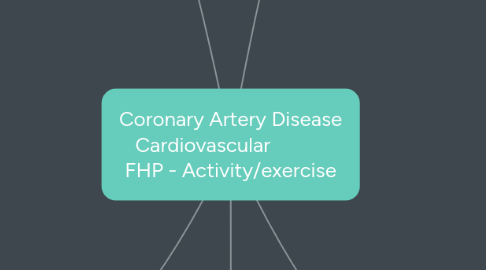
1. Pathophysiology
1.1. What causes CAD
1.1.1. Atherosclerosis
1.1.1.1. Major risk factor
1.1.1.1.1. Blockage of arteries from plaque build up
1.1.2. Risk factors
1.1.2.1. Major
1.1.2.1.1. Increased age
1.1.2.1.2. Family history
1.1.2.1.3. Male gender/ female gender after menopause
1.1.2.2. Modifiable
1.1.2.2.1. Dyslipidemia
1.1.2.2.2. Hypertension
1.1.2.2.3. Cigarette smoking
1.1.2.2.4. Obesity/ sedentary lifestyle
1.1.2.2.5. Atherogenic lifestyle
1.1.2.2.6. Diabetes mellitus
1.1.2.3. Non-traditional
1.1.2.3.1. Markers of inflammation & thrombosis
1.1.2.3.2. Hyperhomocysteinemia
1.1.2.3.3. Adipokines
1.2. What does CAD cause/complications
1.2.1. Angina
1.2.1.1. Coronary arteries narrow, heart cannot receive enough blood with increased demand - such as during physical activity
1.2.1.1.1. Causing chest pain and shortness of breath
1.2.2. Arrhythmia
1.2.2.1. Abnormal heart rhythm
1.2.2.1.1. Inadequate blood supply to heart or damage to heart tissue can interfere with heart’s electrical impulses, causing abnormal heart rhythms
1.2.3. Myocardial ischemia
1.2.3.1. Cholesterol plaque ruptures, forming blood clot. Complete blockage of artery may trigger a heart attack.
1.2.3.1.1. Lack of blood flow to heart may damage heart muscle.
1.3. What other diseases it may lead to
1.3.1. Acute coronary syndrome
1.3.1.1. Sudden reduction or blockage of blood flow to the heart
1.3.1.1.1. Caused by plaque rupture or clot formation to heart’s arteries
1.3.1.2. Also called unstable angina
1.3.2. Myocardial infarction
1.3.2.1. “Heart attack”
2. Assessment
2.1. What you’d assess
2.1.1. Medical history and physical exam when patient has symptoms of chest pain
2.1.2. General assessment of blood circulation
2.1.3. Funduscopic exam
2.1.4. Assess for crepitations or rales
2.1.4.1. Possible sign of heart failure or fluid buildup in lungs
2.2. How you’d assess disease
2.2.1. Blood pressure check
2.2.2. Examine for fatty deposits (xanthomas) under the skin
2.2.3. Evaluate skin color, fingernails, toenails, pulses in the neck, wrists, and feet
2.2.4. Examine back of eye
2.2.4.1. Changes in blood vessels of retina give clues to presence and severity of high blood pressure or diabetes
2.2.5. Listen to lungs for abnormal breath sounds
2.3. What you’d assess for complications of disease
2.3.1. Description of symptoms
2.3.1.1. Nausea, vomiting, shortness of breath, rapid or irregular heartbeat, fatigue
2.4. Tests ordered to assess for CAD
2.4.1. Electrocardiogram (ECG)
2.4.1.1. Records electrical signals as they travel through the heart
2.4.1.2. Can reveal evidence of a previous heart attack or in progress one
2.4.1.3. Portable monitor can be worn for 24 hours
2.4.1.4. Indicates abnormalities such as inadequate blood flow to the heart
2.4.2. Echocardiogram
2.4.2.1. Uses sound waves to produce images of the heart
2.4.2.2. Can be determined whether all parts of the heart are contributing normally to heart activity
2.4.2.2.1. Weak parts may have been damaged by an MI or be receiving too little oxygen
2.4.3. Stress test
2.4.3.1. Exercise stress test
2.4.3.1.1. Done by walking on a treadmill during an ECG
2.4.3.1.2. Done using an echocardiogram, with ultrasound done before and after exercise
2.4.3.2. Nuclear stress test
2.4.3.2.1. Measures blood flow to heart muscle at rest and during stress
2.4.4. Angiogram
2.4.4.1. Also known as cardiac catheterization
2.4.4.1.1. Dye is injected into the coronary arteries through catheter put in arteries in leg
2.4.5. Heart scan
2.4.5.1. Computerized tomography (CT) technology visualizes calcium deposits in the arteries - or narrowing of arteries
3. Nursing Diagnosis
3.1. 1. Actual nursing diagnosis for acute pain
3.1.1. Acute Pain related to heart tissue ischemia, or blockages in the coronary arteries
3.2. 2. Actual nursing diagnosis for activity intolerance
3.2.1. Activity Intolerance related to imbalance between oxygen supply and demand, and the presence of necrotic tissue in myocardial ischemia.
3.3. 3. Actual nursing diagnosis for health management
3.3.1. Ineffective Health Maintenance Related to Inability to Identify Risk Factors Secondary to CAD.
3.4. 4. At risk nursing diagnosis for acute myocardial infarction
3.4.1. Ineffective Tissue Perfusion Related to decreased compliance, contractility, & cardiac output.
4. Nursing Intervention (for each problem - 4)
4.1. 1. Actual nursing implementation for acute pain
4.1.1. Monitor and review the characteristics and location of pain. Monitor vital signs (blood pressure, pulse, respiration, consciousness). Instruct the patient to immediately report instances of chest pain. Teach and encourage the patient to do relaxation techniques. Collaboration in: Giving oxygen and drugs Measure vital signs before and after treatment.
4.2. 2. Actual nursing implementation for activity intolerance
4.2.1. Record the heart rhythm, blood pressure and pulse before, during and after the activity. Explain to the patient about the stages of activity that may be performed by the patient. Show to patient about physical signs that activity exceeds the limit.
4.3. 3. Actual nursing implementation for health management
4.3.1. Describe risk factors for CAD. Discuss immediate benefits of smoking cessation & provide recourse material. Help identify sources of psychosocial & physical support for smoking cessation, dietary, & lifestyle changes. Discuss benefits of regular exercise & identify favorite forms of exercise. Provide & teach information on medications.
4.4. 4. At risk nursing implementation r/t C.A.D. with acute myocardial infarction:
4.4.1. Assess & document vital signs. Assess for changes in level on consciousness, & manifestations of impaired tissue perfusion. Auscultate heart & lung sounds. Monitor ECG continuously. Monitor oxygen saturation levels & administer oxygen as ordered. Administer antidysrhythmic medications PRN. Monitor cardiac markers. Monitor invasive hemodynamic labs.
